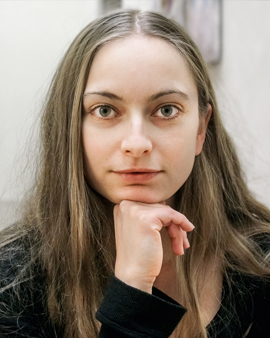Preferably in large formats, figurative scenes in the broadest sense of the word, including depictions of animals and landscapes, stand before us. The motifs appear and elude us. The moment when a scene could be named hardly ever occurs - instead transitions, overlaps, interspersed with patches of colour, geometric elements, drawings, micro-images. Broken colours, in parts even aggressively luminous again, predominantly acrylic, but supplemented by other material components. Glazing, thinned, viscous, forming lumps in some places. Graphic elements made of chalk, charcoal and other drawing pens.
After the overall view, one approaches a canvas and discovers a complicated structure of layers, which make the front and back, the above and below only temporarily visible. Immediately next to it, another finding is revealed. In this respect, painting actually bears the main characteristics of gestural-informal art, but even this is not the final finding.
In this conglomerate of formal expressions of the most diverse nature, figures are repeatedly interwoven, clearly linearly outlined, rarely complete, often as fragments, because they too are part of this flowing, exploratory, interwoven cosmos of forms. Individual parts of the body are modelled in the manner of the Old Masters and then merge with this painterly relief into non-representational formal landscapes. But like a basic motif that is always making itself heard again, the most precise drawings prevail against these seemingly uncontrolled eruptions of form, clear and distinct outlines that evoke associations with the powerful and virtuoso figure concepts of the late Renaissance and Mannerism, but immediately become blurred again.
This is a fundamental principle of Magdalena Cichon's creative method. She does not offer herself or the viewer any final formulations. New constellations between colour, form and structure are constantly appearing. As viewers, we very quickly become aware that we have no claim to reliable recognition or a clear reading.
Magdalena Cichon also starts from the unpredictable and unexpected in her work. Her strategy is based on the potential of the accidental and on her planned interventions, her pictorial answers to these guidelines. It is the field of tension between chance and intention from which her pictures draw their power.
Magdalena Cichon does not draw the form and outline of bodies according to a model, but has internalized these anatomical formulas through long study, so that they have become the pictorial idea, the fundus of form, which then, always giving in to chance, breaks new ground in the act of painting. She describes this as a process that takes place "out of the hand", "without a detour over the head", which she herself observes like an outsider, only to react at a decisive moment to this product of artistic experience and unconscious action.
André Breton understood the activity of the artist less as inventing and imagining than as finding, triggering and exposing, and derived from this as an artistic ideal a "psychic automatism", admittedly in the assumption that he could thus trace the "real" course of thought without any control of reason. The goal of surrealism was to be able to depict an unrestricted totality of reality. This was, of course, a utopia: the communication always remains a fragment of a whole, part of the great continuum, for it is inevitably isolation, selection from an all-embracing context.
Magdalena Cichon does not even succumb to this illusion. She is fully aware of this limitation, this condition and makes it her method - because reflection is an essential characteristic of her work.
www.magdalena-cichon.de
Text: Angelika Steinmetz-Oppelland, 2017
×





_-_(MeisterDrucke-819089).jpg)
_-_(MeisterDrucke-819089).jpg)
.jpg)
.jpg)
.jpg)
.jpg)
.jpg)
.jpg)
.jpg)
.jpg)
.jpg)
.jpg)
.jpg)
.jpg)
.jpg)
.jpg)
.jpg)
.jpg)
.jpg)
.jpg)
.jpg)
.jpg)
.jpg)
.jpg)
_-_(MeisterDrucke-819100).jpg)
_-_(MeisterDrucke-819100).jpg)
.jpg)
.jpg)
.jpg)
.jpg)
.jpg)
.jpg)
.jpg)
.jpg)
.jpg)
.jpg)
.jpg)
.jpg)
.jpg)
.jpg)
.jpg)
.jpg)
.jpg)
.jpg)
.jpg)
.jpg)
.jpg)
.jpg)
.jpg)
.jpg)
.jpg)
.jpg)
.jpg)
.jpg)






